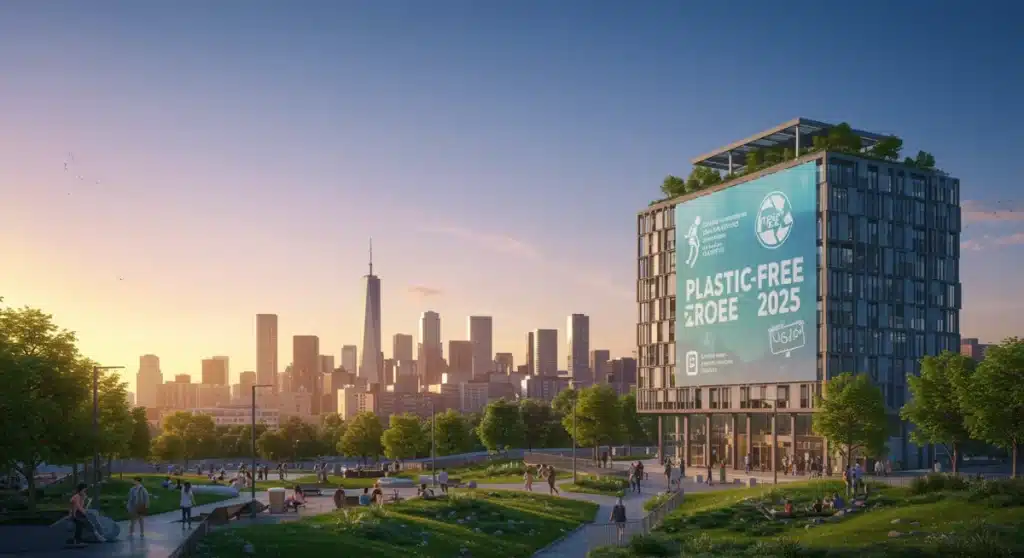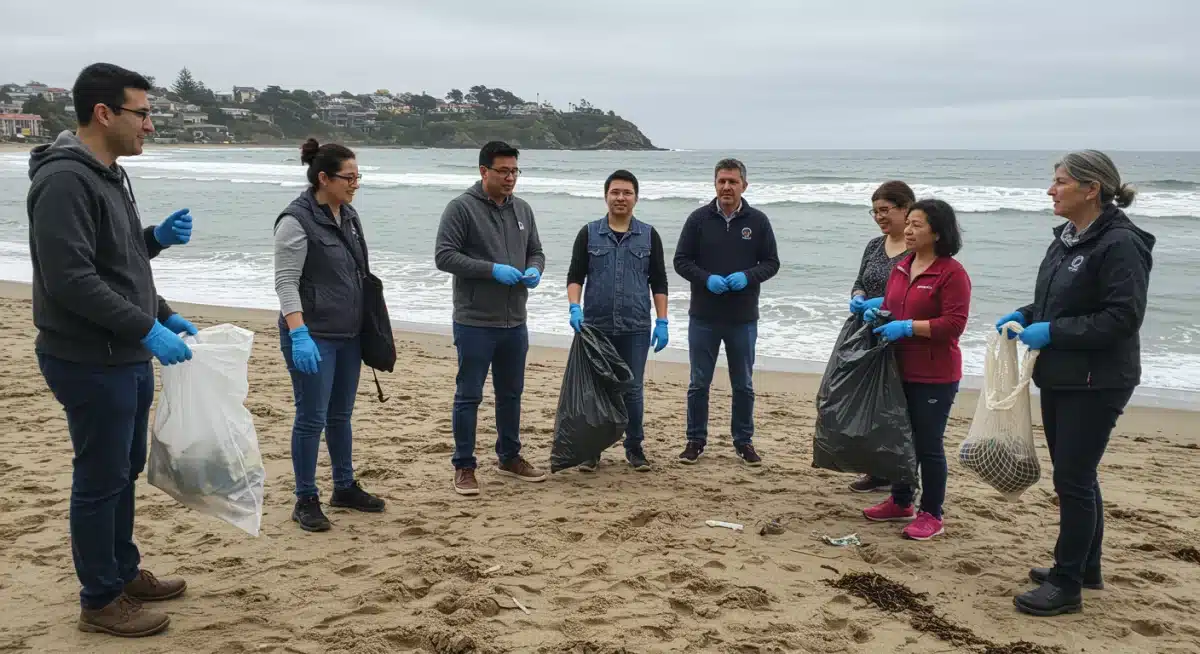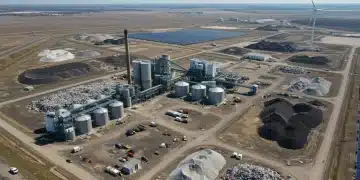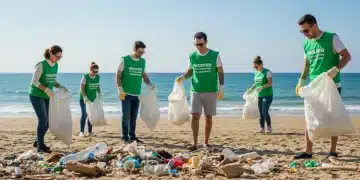Insider Knowledge: Top 3 US Cities Leading Plastic-Free 2025

Breaking news reveals that several municipalities are rapidly advancing their environmental commitments. This report provides Insider Knowledge: Unveiling the Top 3 US Cities Leading in Plastic-Free Initiatives for 2025, highlighting their innovative strategies and the significant progress being made to combat plastic pollution.
The Drive Towards Plastic-Free Urban Centers
The push for plastic-free cities is gaining unprecedented momentum across the United States. As of early 2024, municipalities are increasingly enacting stringent regulations and fostering community engagement to drastically reduce plastic waste ahead of the 2025 target. This concerted effort reflects a growing understanding of plastic’s environmental and health impacts, driving a shift towards more sustainable urban ecosystems.
This movement is not merely about banning single-use plastics; it encompasses a broader systemic change involving businesses, residents, and local governance. The goal is to create circular economies where waste is minimized, and resources are continually reused. Cities are exploring innovative solutions, from advanced recycling technologies to widespread public education campaigns, all aimed at achieving a truly plastic-free future.
Policy Innovations and Regulatory Frameworks
Leading cities are distinguishing themselves through comprehensive policy reforms. These frameworks often include bans on problematic single-use plastic items, mandates for reusable alternatives, and incentives for businesses adopting sustainable practices. The effectiveness of these policies is crucial for driving widespread change.
- Single-Use Plastic Bans: Prohibiting items like plastic bags, straws, and foam containers.
- Extended Producer Responsibility (EPR): Holding manufacturers accountable for the entire lifecycle of their products.
- Reusable Packaging Mandates: Encouraging or requiring businesses to offer reusable options for food and beverages.
- Incentives for Green Businesses: Providing tax breaks or grants for establishments that reduce plastic use.
City 1: San Francisco’s Pioneering Stance
San Francisco continues to solidify its reputation as a leader in environmental sustainability, particularly in its aggressive pursuit of plastic-free goals for 2025. The city’s multi-faceted approach combines strong legislative action with robust community involvement, making it a benchmark for other urban centers. Recent developments indicate an acceleration of their existing policies, pushing for even greater reductions in plastic consumption.
The city’s ‘Zero Waste’ initiative, established over two decades ago, provides a solid foundation for its current plastic-free drive. San Francisco has consistently introduced progressive ordinances, including early bans on plastic bags and styrofoam, and is now expanding its focus to encompass a wider range of plastic products. This proactive stance is generating significant positive impact, as evidenced by decreasing landfill volumes and increased composting rates.
Key Initiatives in San Francisco
San Francisco’s strategy involves several interconnected programs designed to tackle plastic pollution from multiple angles. These initiatives are not only regulatory but also educational, aiming to shift consumer behavior and industry practices.
- Foodware Ordinance: Mandating reusable foodware for dine-in and requiring compostable or recyclable alternatives for takeout.
- Plastic Bottle Ban Expansion: Extending bans on the sale of single-use plastic water bottles in city facilities and events.
- Public Awareness Campaigns: Launching city-wide campaigns to educate residents and businesses on plastic reduction.
- Composting and Recycling Infrastructure: Investing in advanced facilities to handle organic waste and recyclable materials efficiently.
City 2: Seattle’s Comprehensive Approach
Seattle is rapidly emerging as a formidable contender in the race to become plastic-free by 2025, demonstrating a comprehensive and highly effective strategy. The city’s commitment is evident in its bold policy implementations and its dedication to fostering a culture of sustainability among its residents and businesses. Seattle’s approach emphasizes both prevention and responsible disposal, creating a holistic framework for plastic reduction.
Recent reports highlight Seattle’s success in enforcing its existing plastic bans and introducing new measures to tackle hard-to-recycle plastics. The city has seen significant progress in reducing plastic bag and straw usage, and it is now targeting more complex plastic waste streams. This proactive stance is supported by strong public engagement and partnerships with local environmental organizations, showcasing a collaborative model for urban sustainability.
Seattle’s Innovative Programs
Seattle’s innovative programs are designed to address plastic waste at every level, from production to disposal. These initiatives are not only about compliance but also about inspiring change and providing practical solutions for a plastic-free lifestyle.
- Straw and Utensil Ordinance: Requiring businesses to offer single-use straws and utensils only upon request, and prioritizing reusable options.
- Plastic Packaging Reduction: Working with retailers to reduce excessive plastic packaging and promote bulk purchasing.
- Community Collection Events: Organizing regular events for collecting difficult-to-recycle plastics and electronic waste.
- Green Business Certification: Providing certification and support for businesses that meet high environmental standards, including plastic reduction.
City 3: Portland’s Community-Driven Efforts
Portland, Oregon, stands out for its deeply rooted community engagement in achieving plastic-free status by 2025. The city’s initiatives are largely driven by local advocacy groups and a highly environmentally conscious populace, complementing robust municipal policies. This grassroots momentum is a critical factor in Portland’s accelerated progress, demonstrating the power of collective action in environmental stewardship.
The city has a long history of environmental activism, which translates into strong public support for plastic reduction efforts. Portland’s strategies often involve pilot programs in specific neighborhoods, allowing for iterative improvements and widespread adoption. As of late, the city is focusing on expanding its refill and reuse infrastructure, making it easier for residents to avoid single-use plastics in their daily lives.

Grassroots Initiatives and Local Partnerships
Portland’s success is heavily reliant on its strong network of local partnerships and community-led initiatives. These efforts create a supportive ecosystem for plastic reduction, making sustainable choices more accessible and commonplace for residents.
- Refill Station Networks: Establishing widespread public and private refill stations for water, coffee, and household products.
- Zero Waste Challenge: Encouraging residents and businesses to participate in annual challenges to reduce their waste output.
- Reusable Container Programs: Collaborating with local restaurants and cafes to implement reusable container return systems.
- Plastic-Free Markets: Supporting farmers’ markets and local shops that prioritize plastic-free packaging and products.
Challenges and Opportunities for 2025
While these cities are making significant strides, the path to becoming truly plastic-free by 2025 is not without its challenges. Overcoming ingrained consumer habits, ensuring business compliance, and managing the economic implications of transitioning away from plastic require continuous effort and adaptive strategies. Supply chain adjustments and the availability of viable alternatives remain key areas of focus for all leading cities.
However, these challenges also present substantial opportunities for innovation and economic growth within the green sector. The demand for sustainable alternatives is spurring new businesses and technologies, fostering a more resilient and environmentally conscious economy. The insights gained from these pioneering cities will be invaluable for others looking to follow suit.
Overcoming Obstacles to Plastic Reduction
Addressing the complexities of plastic reduction requires multi-pronged solutions. Cities must remain flexible and responsive to new data and technological advancements to maintain momentum.
- Consumer Behavior Change: Implementing effective educational campaigns and providing convenient reusable options.
- Business Adoption: Offering subsidies, technical assistance, and clear guidelines for businesses transitioning to plastic-free alternatives.
- Infrastructure Development: Investing in advanced sorting, recycling, and composting facilities.
- Policy Enforcement: Ensuring consistent and fair application of plastic reduction ordinances.
The Broader Impact and Future Outlook
The collective efforts of San Francisco, Seattle, and Portland are setting a powerful precedent for urban sustainability nationwide. Their successes and lessons learned are providing a roadmap for countless other cities grappling with plastic pollution. As 2025 approaches, the focus will intensify on measuring the tangible impacts of these initiatives and scaling effective strategies to a national level.
The plastic-free movement is not just an environmental endeavor; it is a fundamental re-evaluation of urban living, promoting healthier communities and more sustainable economic models. The leadership demonstrated by these cities contributes significantly to global efforts to combat plastic waste.
Key Takeaways for Other Municipalities
Other cities can draw valuable lessons from the pioneering work being done in San Francisco, Seattle, and Portland. Adapting these strategies to local contexts will be crucial for broader success.
- Strong Political Will: Leadership commitment is essential for enacting and enforcing plastic reduction policies.
- Community Engagement: Involving residents and local organizations fosters widespread adoption and support.
- Business Partnerships: Collaborating with the private sector is vital for developing and implementing sustainable alternatives.
- Continuous Innovation: Embracing new technologies and adaptive strategies to overcome challenges.
| Key Point | Brief Description |
|---|---|
| San Francisco’s Leadership | Pioneering strong legislative action and ‘Zero Waste’ initiatives, expanding bans on plastic bottles and foodware. |
| Seattle’s Comprehensive Strategy | Implementing bold policies like straw/utensil ordinances and packaging reduction, fostering community sustainability. |
| Portland’s Community Focus | Driving plastic-free goals through strong grassroots efforts, refill networks, and reusable container programs. |
| Challenges Ahead | Overcoming consumer habits, ensuring business compliance, and managing supply chain transitions remain key hurdles. |
Frequently Asked Questions About Plastic-Free Cities
A ‘plastic-free’ city aims to significantly reduce or eliminate single-use plastics through bans, promotion of reusables, and robust recycling/composting infrastructure. It involves systemic changes across businesses, residents, and municipal operations to minimize plastic waste generation.
Enforcement typically involves educating businesses and residents, conducting inspections, and issuing fines for non-compliance. Many cities also offer resources and support to help businesses transition to plastic-free alternatives, ensuring a smoother adoption process.
Citizens are crucial. Their participation in recycling, composting, using reusable items, and supporting plastic-free businesses directly contributes to the success of these initiatives. Community cleanups and advocacy also play a significant role in driving change.
While initial transitions can incur costs, long-term economic benefits include reduced waste management expenses, new green job creation, and enhanced city reputation. Many businesses find that reusable systems offer cost savings over time, proving viability.
Major obstacles include changing entrenched consumer habits, ensuring widespread business compliance, and developing adequate infrastructure for reusable and alternative materials. Supply chain limitations for non-plastic products also pose a significant challenge.
Looking Ahead
The advancements in San Francisco, Seattle, and Portland signal an accelerating trend towards urban sustainability. As 2025 approaches, the focus will shift from policy implementation to assessing real-world impact and refining strategies. Expect to see more cities adopt similar aggressive targets, driven by both environmental necessity and the proven success of these pioneering municipalities. The ripple effect of these efforts could fundamentally reshape waste management and consumer culture across the nation, paving the way for a truly greener future.





